Papers by Imam Hasan Reza
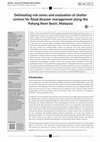
Shelter centres are important locations to safeguard people from helpless situations and are an i... more Shelter centres are important locations to safeguard people from helpless situations and are an integral part of disaster risk reduction (DRR), particularly for flood DRR. The establishment of shelter centres, and their design based on scientific assessment, is crucial. Yet, they are very much related to the geographic location, socio-economic conditions and the livelihoods of the affected communities. However, many parts of the developing world are still lagging behind in ensuring such scientific design. Considering the flood disaster in 2014 that affected the residents living along the Pahang River Basin, in this study we delineate the communities at risk and evaluate the existing shelter centres to determine how they reduce people’s vulnerability to the risks associated with rural and urban landscapes. We used spatial analysis tools to delineate risk zones and to evaluate existing evacuation systems. A flood disaster risk map was produced to determine which communities are living with risks. Subsequently, the distribution of shelter centres examined whether they are able to support people living at the flood risk zones. These centres were also evaluated using a set of international guidelines for effective disaster shelters. This reveals that the number of shelter centres is not adequate. The designation and designing of shelter centres are not being done scientifically. The maps produced here have a lot of potential to support disaster management decisions, in particular site selection and the prioritisation of centres. The study concludes with a set of guidelines and recommendations for structural and non-structural measures, such as alternative livelihoods and the potential of ecotourism, which may improve the resilience among flood-affected communities; and the decision-making process for the overall flood DRR initiatives.

Protected areas in the cities play an important role for nature conservation and sustainable urba... more Protected areas in the cities play an important role for nature conservation and sustainable urban planning. In many occasions however development activities and urban planning ignore this ecological aspect. For sustainable urban planning, understanding the landscape pattern and connectivity importance of urban protected areas and its surroundings are important. Therefore, this study examined: i) landscape pattern changes of three protected areas-Bukit Sungai Puteh, Bukit Nenas and KL Golf Course and ii) their connectivity importance for biodiversity conservation of Kuala Lumpur conurbation. In this study three satellite images (Landsat TM 30 m resolution) of the study areas in 1988, 1996 and 2005 were processed and analyzed using ERDAS Imagine 9.2 and ArcGIS 9.3 to develop land use/land cover maps of the study areas in the three years. Landscape pattern of the maps was analyzed using landscape metrics calculated by Vector Based Landscape Analysis Tools Extension (v LATE) software. Conefor Sensinode 2.2 (CS22) software was used to measure landscape connectivity. Results revealed that over the decades the protected areas experienced highly pressure from anthropogenic activities. Generally, their size is very small and the natural areas within their boundary gradually reduced and fragmented. Analysis also revealed the transformation of natural landscape to the anthropogenic settlements inside all of the three protected areas. This suggests that these protected areas may have lost their capability to support valuable biodiversity if the situation persisted. However, the connectivity analysis showed that some of the large patches of forest outside the protected areas have connectivity importance. Therefore, there is a need for more protected areas in the Kuala Lumpur conurbation to protect valuable biodiversity and also the natural landscapes for sustainable planning of the city.
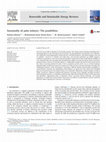
A B S T R A C T Cruel oil or green gold is a dilemma for the oil palm industry. The oil palm indu... more A B S T R A C T Cruel oil or green gold is a dilemma for the oil palm industry. The oil palm industry (planting and milling) has a devastating impact on the environment and ecosystems. Oil palm plantations and expansion cause deforestation , habitat loss, forest fragmentation, biodiversity loss, food chain disruption, soil property changes, water and air pollution, conversion of wetlands and arable lands, and increased greenhouse gas (GHG) emissions, resulting in annual fires as well as increasing both subsidence and flood risk. Palm oil mill effluents (POME) are toxic compounds that cause eutrophication and acidification, pollute terrestrial and aquatic systems and release greenhouse gases. However, the oil palm industry is a million-dollar industry that ensures food security (oil and fat). There is increasing demand for palm oil due to population growth and for use as a biofuel feedstock. Significant higher production per hectare in comparison to other oil crops is the main advantage of oil palm. The anthropogenic pressure on the environment is increasing to fulfil the demand and increasing susceptibility to natural disasters. Therefore, the sustainability of this industry is an urgent need. This critical review identified gaps and researched ways for the oil palm industry to be sustainable. Maintaining ecological integrity (ecological health, connectivity, resilience); justifying land allocation (ecosystem service mapping); providing awareness, good management practices, no/minimum production gaps, high yield and disease resistant cultivar generation and plantations, supplemental forms of alternative sources, zero-waste milling technology; and locating plantations on suitable land without further deforestation can fulfil the oil palm industry's present and future demands without impairing the ecosystem or environment.

The raising of the sea causes salinity intrusion into fresh water zones such as river, lake, floo... more The raising of the sea causes salinity intrusion into fresh water zones such as river, lake, floodplain and other lowlands. Salinity intrusion in the Mangrove forest is a continuous process. However, due to the increasing salinity ecological integrity of the Sundarbans have been largely affected. The compositional and functional aspects of flora and fauna have been changing at a great deal. The objective of this study is to delineate the changes of the structure and composition of the Sundarbans Mangrove Forest due to excess salinity intrusion and how salinity affect its biodiversity, wildlife habitat and other ecosystem components. This study reviewed related literature gathered through an extensive survey of various websites and the secondary data obtained from various departments with necessary modifications. The land use maps collected from the Bangladesh Forest Department were interpreted to achieve an elaborate classification of forest type and its gradual change with increasing salinity. Observations at the periphery of Sundarbans explore the effect of salinity on the population, livestock, aquatic species and the paddy fields. We used ArcGIS 9.3 to visualize the salinity prone zones, the boundary of administrative zones and the forest type to identify the causes and intensity of the issues, and to suggest the appropriate mitigating measures. The study states that the salinity intrusion causes the reduction of fresh water availability in Sundarbans. As a result, fresh water loving species are replaced by the species of the saline zone. Most of the areas are found with the small and bushy typed species that reduce biomass in comparison with their standard volume. The study reveals the effects of salinity intrusion in the Sundarbans Mangrove Forest which may affect its compositional, structural and functional integrity. Long-term and short-term policies are recommended to resolve the issues.

Conservation of biological diversity is a pressing need and protected areas are the cornerstones ... more Conservation of biological diversity is a pressing need and protected areas are the cornerstones for conserving remaining flora and fauna. However, forest dependent livelihood in countries like Bangladesh is making this task very critical. In the case of the poor and forest-dependent livelihood in the Sundarbans area of Bangladesh, an eco-friendly ecotourism may provide an alternative livelihood, which may reduce the overexploitation from the valuable Sundarbans forest ecosystems. Furthermore, this initiative may also serve to aware people on the value of these unique ecosystems. Therefore, this study discusses the scope, benefits and challenges for developing sustainable ecotourism within the protected area. It focuses on the development of a potential site having ecological and archaeological values for sustainable ecotourism inside the Sundarbans Reserve Forest. Developing sustainable tourism spots inside the wildlife hub has a high demand among tourists and it is also necessary for the socioeconomic development of the local community, moreover, the approach of community-based ecotourism (CBEM) is a suitable strategy for the conservation of protected areas.
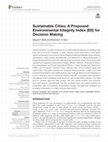
Urban population has been increasing at an unprecedented rate accommodating more than half of the... more Urban population has been increasing at an unprecedented rate accommodating more than half of the world population in cities. Massive human intervention in the tropical region contributes to loss of environmental integrity amplifying challenges like air pollution, deforestation, water scarcity, local extinction, and destruction of natural landscapes. To shape the international community's attitude toward economic, social, and environmental development regarding environmental integrity different methods-Reducing Emissions from Deforestation and Forest Degradation (REDD+), Clean Development Mechanism (CMD)—are introduced. However, these methods have some limitations along with opportunities. This paper reviewed and analyzed existing methods in order to promote environmental integrity in the rapidly growing urban settings. Based on the drawbacks of current methods a new Environmental Integrity Index (EII) is proposed where indicators are selected while considering social, economic, and environmental aspects. The index aims to combine data from field surveys, GIS and remote sensing, and economic and social analysis. We anticipate that this proposed index can support planning for sustainable cities by promoting environmental integrity and balancing biological and ecological components in a highly intricate urban system.
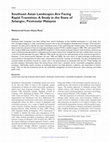
Southeast Asian landscapes have been shifting from natural landscapes to the modified landscapes ... more Southeast Asian landscapes have been shifting from natural landscapes to the modified landscapes at a rate faster than ever. Ecological integrity is under tremendous pressure due to the anthropogenic developmental activities. Little attention, however, has been paid to identify the major underlying causes of this rapid landscape transformation. This article discusses these issues from the point of view of a landscape ecologist. Landsat TM 30 m satellite images of 1988, 1996, and Landsat ETM+
30 m image of 2005 were classified using ERDAS Imagine 9.2. Vector-based Landscape Analysis Tools Extension software was used in analyzing landscape patterns. Landscape size and shape metrics have revealed that the main transformation occurred in the first period (between the years 1988 and 1996) which was due to the rapid extension of the commercial agriculture. However, in the second period (between the year 1996 and 2005), the main driver of rapid landscape transformation occurred due to the expansion of urban areas, transportation networks, housing, and township. The pace of developmental activities breaks all previous records at a faster rate in the second period as compared with the first. These findings will
provide necessary information about the driving forces which have a potential use for sustainable management decision processes. Additionally, results and data on landscape patterns may help scientists, academics, and researchers in further study. They can also be of potential use for the sustainable management of natural resources, urban planning, and livable green cities.
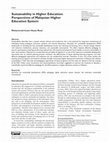
Sustainability describes how a system remains diverse and productive; this is the potential for l... more Sustainability describes how a system remains diverse and productive; this is the potential for long-term maintenance of well-being having ecological, economic, political, and cultural dimensions. Education for sustainable development (ESD) emphasizes on including the key sustainable development issues into teaching and learning, that is, climate change, disaster risk reduction, biodiversity, poverty reduction, and sustainable consumption. This effort requires effective pedagogy to
ensure a participatory teaching and learning method that will motivate and empower future leaders to ensure sustainability in their social systems. Malaysia has incorporated the principles of Agenda 21 as one of the important sustainable development documents into its national planning process. However, the effectiveness of these teaching–learning programs, and their effective pedagogical approaches and endpoints are not satisfactorily ensured. Therefore, at first, this article reviews the
existing various programs and research activities of public and private higher educational institutions in Malaysia that address sustainability. It then discusses the pedagogical approaches of these programs and how they are related to the key concept of the ESD. Finally, some conclusions and recommendations have been suggested to improve the initiatives to develop a scientifically sound and effective pedagogy for the ESD programs in higher education systems in Malaysia.
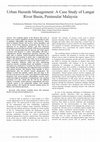
—The escalating impact of the disasters that occur in urban areas requires significant attention ... more —The escalating impact of the disasters that occur in urban areas requires significant attention and planning in order to minimize vulnerability and disaster risk. However, efforts made to minimize disaster risk involves various disciplines, and can be viewed from numerous perspectives that need to be addressed in an integrated manner, and then effectively formulated to provide long term benefit. With the great potential of the GIS, incorporating both the physical and social aspects associated with disasters to reduce vulnerability will form a comprehensive disaster management operation. Therefore, this study aims to translate various hazardous information that is physical and socioeconomic in nature into a comparable layer within a GIS platform to assess the study area in an integrated manner. We have conducted a study in the Upper-Langat river basin, Peninsular Malaysia, which has been experiencing numerous disasters including floods and landslides. A hazard assessment was conducted to: systemize the intricacy of the geo-data, identify the predisposing and triggering factors associated with natural hazards, and integrate them spatially to derive multi-hazards data for effective hazard management. The findings revealed that spatially explicit data and maps at the relevant scale based on the surface and subsurface information, integrated with socioeconomic vulnerabilities, provide better results that might be beneficial for multi-disaster risk reduction operations. It is also evident that the GIS has the sufficient capacity to translate various physical, compositional, and socioeconomic aspects to the comparable outputs. Such spatially explicit products will expedite the decision making process for disaster risk reduction operations.

The change in climate has been observed over comparable periods of time. Mangrove ecosystem and i... more The change in climate has been observed over comparable periods of time. Mangrove ecosystem and its biodiversity are threatened due to climate change. Sundarbans mangrove ecoregion situated in Bangladesh (~62%) and India (~38%) is a bioclimatic zone. Sundarbans is one of the largest reserves for the Bengal tiger (Panthera tigris tigris L) which is the top predator. Therefore, it helps to regulate the number and distribution of prey, which in turn impacts forest structure, composition and regeneration. As climate change affects the flora and fauna in this ecosystem, these may be impaired because of migration of the species. The tigers become stray from forests to human inhabitants and causes tiger human conflicts which often results in retaliatory killings of tiger and human and or livestock. Therefore, the main objective of this study is to identify the effects of climate change towards the salinity intrusion and biodiversity, modification of floral and faunal composition, habitat loss and behavioral change of wildlife, which ultimately identify the factors for accelerating tiger human conflicts. It reviewed related literature through various websites and the secondary data were quoted with necessary modification. The primary data obtained from the office records of Bangladesh Forest Department and a social surveying was conducted on livelihood profile of the people living surrounding the Sundarbans to identify the relations between tiger attacking and their livelihood and living style. We used ArcGIS 9.3 to visualize the tiger habitat and trigger up the causes of root of conflicts between human and tiger. The results reveal the climate change effects in the Sundarbans Mangrove forest through changing its biodiversity composition in terms of loss of wildlife habitats which is responsible for accelerating tiger human conflicts. It suggests, a social and cultural revolution for sustainable alternative livelihood of forest-dependent population i.e., Alternative Income Generation (AIG), modification of the formal legal system, institutional development and in depth research can minimize these issues towards the sustainability of Sundarbans mangrove forest.
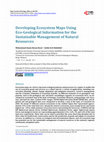
Ecosystem maps are vital to represent ecological patterns and processes in a region. It enables t... more Ecosystem maps are vital to represent ecological patterns and processes in a region. It enables the use of ecosystem goods and services as a robust unit for a variety of applications, including conservation planning, climate change adaptation and mitigation measures, resource management, and the economic estimation of ecosystem benefits. As different elements of eco-geological components , such as the geological, soil, and biotic assemblages organize an ecosystem; here, we developed an ecosystem map of the State of Selangor, Peninsular Malaysia, using geology, soil, elevation , and land-use data. Landsat ETM+ images, ASTER Digital Elevation Model (DEM) data, and digitized soil and geological data were integrated to develop a map of the types of ecosystem for 2005. We found 19 different natural ecosystems in the studied region that represented approximately 35% of the total land area. Among the natural ecosystems, peat-swamp forest represents highest (at ~10%), while montane ericaceous forest representing the lowest (at ~0.008%) and the hill dipterocarp quartz forest, lowland dipterocarp sandstone forest, upper dipterocarp quartz forest, and mangrove forest are representing approximately 6.4%, 4.6%, 3% and 2.6% of the total land area respectively. These data can be used to prioritize the areas deserving attention due to their value for biodiversity conservation and for the production of goods and supply of ecosystem services. In addition to a variety of ecological and environmental aspects, such an ecosystem map has potential use for the sustainable management of natural resources at the national, regional, continental, and global scales.
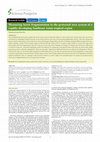
Forest fragmentation has become a global concern for conservation of important habitats as well a... more Forest fragmentation has become a global concern for conservation of important habitats as well as biodiversity. Protected areas that have been a cornerstone for safeguarding biological diversity are also facing enormous stress due to the increasing anthropogenic activities. This study estimates the degree of spatial fragmentation in the protected area system and landscape fragmentation in the State of Selangor, peninsular Malaysia using modern geo-spatial technology. Landsat TM 30 m satellite images of 1988 and 1996 and Landsat ETM+ 30 m satellite image of 2005 were used as base maps in this study. Results show forest fragmentation index (FI) in the entire extent of the state of Selangor was changed at a moderate rate from the year 1988 (34.33) to 1996 (36.33); however, it increased dramatically in 2005 and reached 41.58. Among nine of the protected areas in the study area, Fraser’s Hill wildlife protected area shows a relatively unchanged FI, which was lower than 1. Bukit Kutu wildlife protected area was relatively less fragmented in 1988 and 1996 (FI lower than 1.5), but became highly fragmented in 2005 (20.04). However, the other five protected areas have been fragmented at a great degree in all three experimented years and increased with the changes of time. These findings indicate how protected areas have been fragmenting inside their legislative boundaries. Thus, it is important to take necessary initiatives in order to improve the representativeness of ecosystems in the protected area system and to safeguard biodiversity in this mega diverse ecoregion.

Ecosystem organization is a very complex system. Naturalness of ecological systems is in a tremen... more Ecosystem organization is a very complex system. Naturalness of ecological systems is in a tremendous threat due to anthropogenic disturbances. It is important to understand the characteristics of anthropogenic disturbances which have been changing spatial processes and thus affecting the ecological integrity. A combination of science and policy, relating science with socio-economic perspectives is very much required to combat such challenges. An index of ecological integrity can be the right approach to monitor, evaluate and classify the state of the ecosystems in the broader scale for conservation planning. Such understanding can build up a bridge between stakeholders of different hierarchies and disciplines to work in the same platform. Therefore, this paper reviews and examines: (i) the characteristics of critical issues that are severe threats to regional landscapes, (ii) the consequences of such pressures on the components of ecosystem, and (iii) a brief outline for a composite index for ecological integrity. The objective is whether a composite index of ecological integrity (IEI) can be develop for the sustainable management planning for the conservation of natural resources in a broader scale.
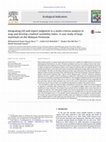
Ecological Indicators
Landscape and regional planning Multi-criteria decision making (MCDM) Habitat suitability mapping... more Landscape and regional planning Multi-criteria decision making (MCDM) Habitat suitability mapping Wildlife conservation a b s t r a c t Many habitat patches in tropical landscapes have become less suitable for wildlife due to an increase in anthropogenic disturbances. An index of habitat suitability based on the ecological factors that collectively determine the suitability of an organism's habitat is important for conservation planning. However, a widely accepted and comprehensive multi-criteria habitat suitability index for umbrella species is still lacking, particularly in areas where information related to the biology and ecology of the species of interest is not available. Therefore we develop preliminary habitat maps and measure the degree of habitat suitability for large mammals, focusing on four umbrella species in the State of Selangor, Peninsular Malaysia: Panthera tigris jacksoni (Malayan tiger), Tapirus indicus (Malayan tapir), Helarctos malayanus malayanus (Malayan sun bear), and Rusa unicolor cambojensis (sambar deer). The former two are endangered and the latter two are vulnerable according to the IUCN Red List. The suitability of habitat patches for each species was measured across the entire study area as well as in nine wildlife protected areas by integrating GIS data and expert opinion. Expert opinions were used as the source of information regarding the stresses faced by the species because there was insufficient information available from ground surveys.

Environmental displacement has become a contemporary global concern due to the increasing intensi... more Environmental displacement has become a contemporary global concern due to the increasing intensity of climate change effects on peoples around the world. In recent times, this issue has become a socio-political problem due to the increasing rate of displacement within and outside of a country. Therefore, environmental security has emerged as a new concept and growing issue within the domain of human security. This development has become a political issue, due to socio-economic and cross border involvement as well as problems that have emerged within countries. Also, remarkably little attention has been given to analyze, monitor, evaluate and predict changes that are involved in the causes and consequences of climate change induced vulnerability and human security. Similarly, detailed studies on the causes due to such contemporary issues are lacking, globally. For this paper, it is intends to identify causes, consequences and projections of environmental degradation, and the vulnerability of human livelihood caused by climatic and hydro-meteorological disasters in Malaysia. Therefore, this paper discusses issues to do with flood-related vulnerability both in rural and urban areas, and its impact on human security in Malaysia. It also outlines the potential scientific tools that may be applied to predict, evaluate and plan to overcome the problem. The prime objective is to identify and to develop a new paradigm integrating tools of socio-economic, cultural and scientific aspects. It is assuming that, this effort would be able to put forward a theme to integrate scientists, social scientists and policy makers to work together to solve such issues.
Self assembled potential bio-nanocarriers for drug delivery
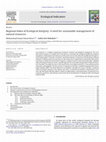
Ecological Indicators, Jan 1, 2010
An ecosystem is a complex composition of physical, chemical and biological components. This compl... more An ecosystem is a complex composition of physical, chemical and biological components. This complex system remains in a healthy state if the system can maintain the ecological equilibrium among its components. Anthropogenic disturbances are the prime stressors that affect this equilibrium through creating fragmentation, ecosystem sensitivity, loosening landscape connectivity and disrupting ecological integrity. As different types of ecosystem are interconnected, a comprehensive monitoring and evaluating criteria is needed for measuring its integrity at regional level for conservation planning. A Regional Index of Ecological Integrity can be a suitable approach for sustainable management of regional ecosystem. Therefore, this paper presents (i) the characteristics of ecological integrity, (ii) the spatial processes induced by anthropogenic stressors and (iii) an approach to develop a composite Regional Index of Ecological Integrity (RIEI). The prime objective is to establish a thought and a way to develop a composite index of ecological integrity at the regional level. Here, we demonstrate different compositional, structural and functional indicators/indices related to fragmentation, representativeness of protected area, ecosystem sensitivity, and landscape connectivity for the development of a Regional Index of Ecological Integrity (RIEI).
Landscape Pattern and Connectivity Importance of Protected Areas in Kuala Lumpur Conurbation for Sustainable Urban Planning
Book
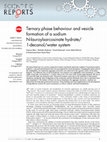
Scientific Reports, Jan 1, 2011
The phase behaviour of a system composed of amino acid-based surfactant (sodium N-lauroylsarcosin... more The phase behaviour of a system composed of amino acid-based surfactant (sodium N-lauroylsarcosinate hydrate), 1-decanol and deionised water was investigated for vesicle formation. Changing the molar ratio of the amphiphiles, two important aggregate structures were observed in the aqueous corner of the phase diagram. Two different sizes of microemulsions were found at two amphiphile-water boundaries. A stable single vesicle lobe was found for 152 molar ratios in 92 wt% water with vesicles approximately 100 nm in size and with high zeta potential value. Structural variation arises due to the reduction of electrostatic repulsions among the ionic headgroups of the surfactants and the hydration forces due to adsorbed water onto monolayer's. The balance of these two forces determines the aggregate structures. Analysis was followed by the molecular geometrical structure. These findings may have implications for the development of drug delivery systems for cancer treatments, as well as cosmetic and food formulations. S tudies of vesicle formation and morphology for potential applications are rapidly growing areas of research 1 . The research acquires immense importance owing to the ability of vesicles to mimic cell properties. A vesicle acts as a nanocarrier with its capacity to encapsulate water-soluble drugs in its aqueous core and water-insoluble drugs in its membrane 2,3 . Beyond phospholipids, a number of synthetic surfactants are known to self-assemble into vesicle structures 4-8 . These surfactants exhibit a wide variety of self-assembled structures, all of which have potential applications in drug delivery and, cosmetic and food formulations. However, the toxic effects of many synthetic surfactants have limited their use in these fields. This adverse consequence can be avoided by selecting a suitable biocompatible system for vesicle preparation.
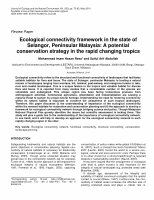
Journal of Ecology and The …, Jan 1, 2010
Ecological connectivity refers to the structural and functional connectivity of landscapes that f... more Ecological connectivity refers to the structural and functional connectivity of landscapes that facilitates suitable habitats for flora and fauna. The state of Selangor, peninsular Malaysia, is hosting a natural mosaic of landscapes ranging from montane, hill, lowland, peat-swamp, and mangrove forests to lake, river and coastal landscapes. This is a unique feature in the tropics and valuable habitat for diverse flora and fauna. It is reported from many studies that a considerable number of the species are vulnerable and endangered. This unique region has been facing tremendous pressure from anthropogenic activities. Commercial agriculture, urbanization and industrialization are causing a massive threat to sustain its unique natural heritage. Understanding the need for restoring connectivity within its natural habitat is important to conserve the uniqueness of such tropical landscapes. Therefore, this paper discusses (i) the understanding of importance of the ecological connectivity within the remnant habitats for restoration and conservation planning and (ii) the approach to develop a framework for ecological connectivity network through bridging science and policy. Though Malaysian National Physical Plan grossly identifies the issues but scientific assessment is lacking there. This study will give a guide line to the understanding of the importance of ecological connectivity network, in one hand, and it will help to develop an approach for the ecological connectivity network in such rapidly changing region in the other.








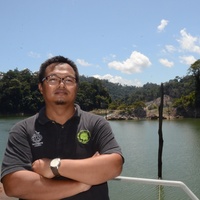

Uploads
Papers by Imam Hasan Reza
30 m image of 2005 were classified using ERDAS Imagine 9.2. Vector-based Landscape Analysis Tools Extension software was used in analyzing landscape patterns. Landscape size and shape metrics have revealed that the main transformation occurred in the first period (between the years 1988 and 1996) which was due to the rapid extension of the commercial agriculture. However, in the second period (between the year 1996 and 2005), the main driver of rapid landscape transformation occurred due to the expansion of urban areas, transportation networks, housing, and township. The pace of developmental activities breaks all previous records at a faster rate in the second period as compared with the first. These findings will
provide necessary information about the driving forces which have a potential use for sustainable management decision processes. Additionally, results and data on landscape patterns may help scientists, academics, and researchers in further study. They can also be of potential use for the sustainable management of natural resources, urban planning, and livable green cities.
ensure a participatory teaching and learning method that will motivate and empower future leaders to ensure sustainability in their social systems. Malaysia has incorporated the principles of Agenda 21 as one of the important sustainable development documents into its national planning process. However, the effectiveness of these teaching–learning programs, and their effective pedagogical approaches and endpoints are not satisfactorily ensured. Therefore, at first, this article reviews the
existing various programs and research activities of public and private higher educational institutions in Malaysia that address sustainability. It then discusses the pedagogical approaches of these programs and how they are related to the key concept of the ESD. Finally, some conclusions and recommendations have been suggested to improve the initiatives to develop a scientifically sound and effective pedagogy for the ESD programs in higher education systems in Malaysia.
30 m image of 2005 were classified using ERDAS Imagine 9.2. Vector-based Landscape Analysis Tools Extension software was used in analyzing landscape patterns. Landscape size and shape metrics have revealed that the main transformation occurred in the first period (between the years 1988 and 1996) which was due to the rapid extension of the commercial agriculture. However, in the second period (between the year 1996 and 2005), the main driver of rapid landscape transformation occurred due to the expansion of urban areas, transportation networks, housing, and township. The pace of developmental activities breaks all previous records at a faster rate in the second period as compared with the first. These findings will
provide necessary information about the driving forces which have a potential use for sustainable management decision processes. Additionally, results and data on landscape patterns may help scientists, academics, and researchers in further study. They can also be of potential use for the sustainable management of natural resources, urban planning, and livable green cities.
ensure a participatory teaching and learning method that will motivate and empower future leaders to ensure sustainability in their social systems. Malaysia has incorporated the principles of Agenda 21 as one of the important sustainable development documents into its national planning process. However, the effectiveness of these teaching–learning programs, and their effective pedagogical approaches and endpoints are not satisfactorily ensured. Therefore, at first, this article reviews the
existing various programs and research activities of public and private higher educational institutions in Malaysia that address sustainability. It then discusses the pedagogical approaches of these programs and how they are related to the key concept of the ESD. Finally, some conclusions and recommendations have been suggested to improve the initiatives to develop a scientifically sound and effective pedagogy for the ESD programs in higher education systems in Malaysia.